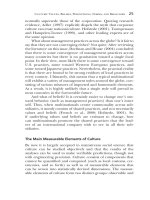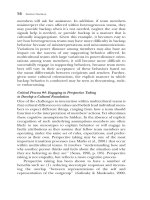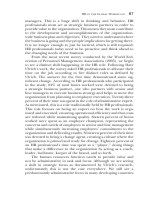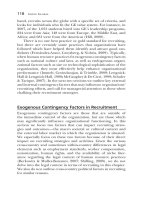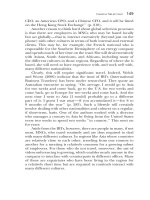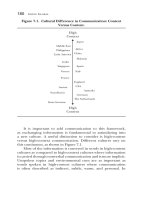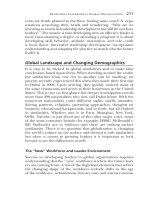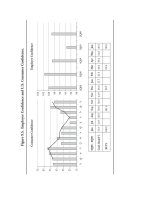Going Global Practical Applications and Recommendations for HR and OD Professionals in the Global Workplace J-B SIOP Professional Practice Series by Kyle Lundby, Jeffrey Jolton and Allen I. Kraut_4 pdf
Bạn đang xem bản rút gọn của tài liệu. Xem và tải ngay bản đầy đủ của tài liệu tại đây (506.46 KB, 28 trang )
Multicultural Teams: Critical Team Processes and Guidelines 47
based on their cultural orientation. The interaction within these
teams primarily reflect intercultural interaction versus intracul-
tural interaction.
In seeking to provide guidance to organizations, there has
been a fair amount of work conducted that examines intracul-
tural differences in group- or team-based work. For example,
research has shown that cultural differences have implications for
cooperation (for example, Kirkman & Shapiro, 2001; Cox et al.,
1991), communication (Conyne et al., 1999), feedback (Earley
et al., 1999), conflict type (Elron, 1997; Mortensen & Hinds,
2001), cohesion (Man & Lam, 2003; Elron, 1997), team efficacy
(Gibson, 1999), adaptation (Harrison, McKinnon, Wu, & Chow,
2000), decision making (Kirchmeyer & Cohen, 1992), and team
performance (Elron, 1997; Gibson, 1999; Kirkman & Shapiro,
2001; Man & Lam, 2003; Matveev & Nelson, 2004; Gelfand, Erez,
& Aycan, 2007). However, as organizations increasingly rely on
multicultural work teams, often overlooked are the challenges
inherent in leading and working within teams in which individu-
als have vastly different backgrounds, traditions, motivations, and
concerns (Dinwoodie, 2005).
If there are cultural differences in teamwork when looking
intraculturally across cultures, the challenges they pose are com-
pounded when multiple cultures are placed within a single team;
however, it has been arguedthat these teams can be effective to the
degree to which they are able to manage the need for consensus
versus the need for diversity (Argote & McGrath, 1993). Although
diversity in skills and perspectives may benefit multicultural teams,
the team also needs a degree of common ground in order to facil-
itate coordinated action and the understanding that leads to that
coordination (Argote & McGrath, 1993). Within organizational
teams diversity is often a feature that cannot be escaped, but is
a function of the operating environment. The question becomes
‘‘What does within team diversity in multicultural teams mean for
team interaction and correspondingly teamwork?’’
The purpose of the current chapter is to first highlight some
of the challenges inherent in working within multicultural teams.
In doing so, key processes and emergent states will be briefly
described, resulting in a framework within which to think about
multicultural teams. Next we identify several guidelines that may
48 Going Global
be used by practitioners. These guidelines are grouped based
on their temporal nature (that is, whether they occur before
interaction, during interaction, or post interaction).
What Are the Implications of Intracultural
Differences for Teamwork?
National culture has been defined in many ways: as (1) ‘‘ a
coalescence of discrete behavioral norms and cognitions shared
by individuals within some definable population that are distinct
from those shared with other populations’’ (Lehman, Chiu, &
Schaller, 2004, p. 690), and (2) ‘‘shared motives, values, beliefs,
identities, and interpretations of meanings of significant events
that result from common experiences of members of collectives
and are transmitted across age generations’’ (House & Javidan,
2004, p. 15). Although there is no universally accepted definition
of culture, after reviewing the multitude of definitions within the
social sciences, Triandis (1996) argues that there is wide agree-
ment across definitions that culture consists of ‘‘shared elements
that provide standards for perceiving, believing, evaluating, com-
municating, and acting among those who share a language, a
historic period, and a geographic location’’ (Shweder & LeVine,
1984, p. 408).
The challenge within multicultural teams lies within the fact
that individuals who often have extremely disparate conceptual-
izations of how teams should function are required to engage in
interdependent interaction (Ilgen, LePine, & Hollenbeck, 1997).
Moreover, these culturally based differences are often implicitly
held and are only recognized once the team is heading down a
path to derailment. Gibson and Zellmer-Bruhn (2001) empirically
examined the idea that individuals from different cultures may
have different teamwork prototypes (i.e., metaphors), which in
turn, reflect underlying assumptions about a team’s functionality
and structure. Specifically, interviews were conducted in which
individuals from a variety of cultures were asked general questions
about teamwork. The transcripts from these interviews were then
content coded and sorted based on thematic similarities.
Results indicated the emergence of five differential metaphors
for teams (for example, sports, military, family, associates, and
Multicultural Teams: Critical Team Processes and Guidelines 49
community). Within individualistic cultures there was a ten-
dency for teams to be described in terms of sports and associate
metaphors. Sports metaphors reflected a conceptualization of
teams whereby roles are explicitly defined, there is little hierar-
chy, membership tends to be voluntary, scope of activity is fairly
narrow, and objectives tend to be well defined (Gibson & Zellmer-
Bruhn, 2002). Associate metaphors were used to conceptualize
a view of teams in which there was little role definition, a nar-
row scope of activity related to professional work, and objectives
were explicit, yet evolving and not focused solely on task-related
outcomes (Gibson & Zellmer-Bruhn, 2002).
Conversely, metaphors reflecting family and community
tended to be used most often with collectivists. Herein, teams
were conceptualized using a family metaphor in which there was
a paternalistic hierarchy, activity scope was broad, and objectives
were more social in nature (Gibson & Zellmer-Bruhn, 2002). In
contrast, community metaphors indicated a conceptualization
whereby roles were informal and shared, activities and objectives
were broad in scope and somewhat ambiguous. Perhaps used
less often was the military metaphor, being primarily used by
those valuing power distance (Gibson & Zellmer-Bruhn, 2001).
This metaphor reflected a strict hierarchical structure, limited
scope, and task-focused salient outcomes. These differences
in metaphor use point to the potential difficulty in building
shared cognitive structures (for example, shared mental models,
transactive memory systems) within multicultural teams.
Similar in nature is work that has shown that culture has
an impact on what is considered success in work groups. For
example, Sanchez-Burks, Nisbett, and Ybarra (2000) reported
that cultures that were more collectivistic (for example, Mexico)
valued socioemotional outcomes over task-based outcomes. The
reverse was true for a sample of Anglos. The work by Sanchez-
Burks et al. (2000) as well as that by Gibson and Zellmer-Bruhn
(2001; 2002) offer important insights into challenges that may
arise for individuals working within multicultural teams, as well as
for the leaders responsible for directing and shaping those teams.
For example, Gibson’s work suggests that within a multicultural
team it is likely that the members may come to the team with
disparate ideas pertaining to role structure, activity scope, and
50 Going Global
team functioning. In turn, these expectations will drive different
behavioral responses and attributions. These disparate expecta-
tions are often latent and, in turn, foster misattributions. Similarly,
the work by Sanchez-Burks et al. (2000) suggests different motiva-
tional bases for members from different cultures. In turn, these
differences may result in frustration and a lack of psychological
safety within multicultural teams. Leaders must take into account
and balance these disparate motivations so that the team as a
whole remains motivated.
Given this complexity, we next discuss several processes and
states which must be enacted and sometimes culturally negotiated
in order for multicultural teams to be effective and overcome the
inherent challenges often caused by diversity. Multicultural teams
who are able to implement these processes in a culturally appro-
priate manner have the potential for positive team outcomes. The
following list provides a summary of these critical components.
Critical Components Driving Effectiveness in Multicultural Teams
• Process Components
1. Engaging in leadership—creating and maintaining
coherence
2. Ensuring clear and meaningful communication
3. Engaging in supportive behaviors to maximize team synergy
4. Engaging in perspective taking to develop a cultural
foundation
5. Engaging in negotiation to find common ground
• Emergent States
6. Creating a sense of psychological safety to facilitate
interaction
7. Forming compatible cognitive structures to aid coordination
Components Driving Effectiveness
in Multicultural Teams
There has recently been a notable distinction in the teams litera-
ture; researchers are beginning to better delineate the nature
of team process. Marks, Mathieu, and Zaccaro (2001) argue
Multicultural Teams: Critical Team Processes and Guidelines 51
that researchers have not been conceptually disciplined when
it comes to the constructs which are identified as process, often
confounding process with emergent states. Accordingly, team pro-
cess refers to ‘‘members’ interdependent acts that convert inputs
to outcomes through cognitive, verbal, and behavioral activities
directed toward organizing taskwork to achieve collective goals’’
(Marks, Mathieu, & Zaccaro, 2001, p. 357). Conversely, emergent
states are viewed as a bit more static than process and have been
defined as ‘‘constructs that characterize the properties of the
team that are typically dynamic in nature and vary as a function
of team context, inputs, processes, and outcomes’’ (Marks et al.,
2001, p. 357). These constructs often represent cognitive, affec-
tive, and motivational components and can be viewed as inputs
to and outcomes of team process. Due to the diversity present
within multicultural teams, it is often difficult to promote these
emergent states. In turn, this has important implications for the
manner in which processes (such as leadership, communication,
supportive behaviors) are enacted within the team.
In delineating a framework (see Figure 3.1) within which to
examine the components which facilitate effectiveness in multicul-
tural teams we rely on the current state-of-the science and employ
the distinction between process and emergent states. In addition,
while there are a multitude of process and state variables which
could be argued to be challenging and essential for multicultural
teams space constraints limit discussion to those we believe are
most essential.
Delineation of Process Components
In the United States teams have been defined as two or more
individuals interacting together in an adaptive interdependent
manner towards a shared or common goal (Salas et al., 1992).
While we expect this definition will hold across cultures the opera-
tionalization of the behaviors contained within might be expected
to differ. However, at a bare minimum we argue that in any type
of multicultural team the following three process variables are
going to form the foundation of effective teamwork: negotiation,
communication, and supporting behavior. In addition, especially
important within multicultural teams are the additional processes
52 Going Global
Figure 3.1. Framework for Thinking About Multicultural
Team Performance.
Core Process
Enablers
Shared
Mental
Models
Psychological
Safety
Core Processes
Negotiation
Communication
Supporting
Behavior
Multicultural
Team
Performance
Transactive
Memory
Systems
Perspective
Taking
Leadership
of perspective taking and leadership as these two processes assist
in providing a way forward amongst the challenges that may be
posed in enacting the other process variables. See Figure 3.1 for a
visual illustration.
Critical Process #1: Engaging in Leadership—Creating
and Maintaining Coherence
Leadership has been argued to play a pivotal role in deter-
mining team effectiveness (see Burke, Stagl, Klein, Goodwin,
Salas, & Halpin, 2006). Specifically, leadership is the mechanism
through which the shared cognition, affect, and behavior within
teams is promoted so that coordinated action can occur. Leaders
ensure that the team has clear, compelling direction, an enabling
structure, supportive organizational context, and expert coaching
available (Hackman, 2002). It is within this vein that leaders can
facilitate a team’s ability to adapt by choosing the timing and
mechanisms through which to intervene in team process to allow
reflection upon methods and procedures to take place (Gersick
& Hackman, 1990; Hackman & Wageman, 2005).
Within multicultural teams, leadership actions become even
more important given the likelihood of the team’s exhibiting
Multicultural Teams: Critical Team Processes and Guidelines 53
degradations in its coherence (shared understandings, behavior,
and affect), which in turn, promotes the coordinated action indica-
tive of effective teams. Leadership interventions can help teams
adapt to difficulties in execution and process loss. For example,
it has been argued that within multicultural teams leaders should
promote a hybrid culture (Earley & Mosakowski, 2000) in order to
mitigate process challenges. This hybrid culture is not reflective of
any one culture that currently exists within the team, but reflects
a new superordinate culture. Yet the picture is complicated,
as research has indicated that there are differences across cul-
tures concerning what is deemed ‘‘effective’’ leadership (House,
Hanges, Javidan, Dorfman, & Gupta, 2004; Bantz, 1993). More-
over, even when leadership prototypes are similar across cultures
(for example, charismatic leadership), often the manifestations of
these prototypes are culturally contingent (see Mehra & Krishnan,
2005; Pillai & Meindl, 1998; Den Hartog & Verburg, 1997). As
such it is not enough to simply train leaders to act in a charismatic
fashion, because what is charismatic may differ across cultures.
Also important to note for leaders of multicultural teams is that
theoretical work has suggested that when there are large variations
in values pertaining to uncertainty avoidance within multicultural
teams it may be more difficult for stable norms to emerge (Bantz,
1993). This is important, for it is often a leadership function to
set the norms for the team. It has also been argued that key
leadership functions such as boundary spanning are encouraged
more within collectivistic as compared with individualistic settings
(Golden & Veiga, 2005). This can have a tremendous impact on
the team as boundary spanning is the manner by which teams
adapt to the environment and the way in which new information
comes into the team. Thus, although there are several challenges
to providing leadership within multicultural teams, leaders can
assist in preventing communication breakdowns (Ayoko et al.,
2002) and facilitate the sharing of unique information among
the team (Baba, Gluesing, Ratner, & Wagner, 2004). Moreover,
within multicultural teams there is likely to be more attention
paid to interpersonally related leadership behaviors as compared
to task leadership behaviors (Watson et al., 2002). Leaders should
be cognizant of this and set cooperative goals and, when conflict
54 Going Global
occurs, employ cooperative conflict management strategies (Chen
et al., 2006).
Critical Process #2: Ensuring Clear and Meaningful Communication
Communication is essential to teams in that it helps members
develop and update the shared knowledge structures that serve
to guide adaptive action, and it provides the foundation for
mutual monitoring and backup behavior. The importance of this
process is seen in that cross-cultural communication competence
has been shown to be related to performance in multicultural
teams (Matveev & Nelson, 2004). Despite the importance of clear
communication, difficulties in communication lie at the heart of
many of the challenges to interacting within a multicultural team.
Within multicultural teams there are often communication
challenges in terms of differences in language and dialect, commu-
nication norms, rate, duration, and expressivity of communication
(including urgency and affect). In addition, it is often the
case that much information—or ‘‘the intended meaning’’ of
communication—is lost within multicultural teams. Differences
in the rate of communication as well as the structure of communi-
cation across cultures can lead to challenges within multicultural
teams. For example, cultures differ on the extent to which they
expect the meaning to be explicitly stated within the actual com-
municated message (and thereby communication tends to be
more dense) or whether it is implicitly implied based on out-
side contextual information (see high-low context, Hall & Hall,
1990). Also related to the nature of communication, Earley et al.
(1999) found that individual and group-based feedback fostered
collective efficacy in members with a collectivist orientation, yet
members with an individualistic orientation were more likely to
have a sense of collective efficacy when feedback was geared
more individually. Finally, within multicultural teams it is not only
the structure of communication that may pose challenges. But
the actual source of the communication message (that is, the
sender) may affect not only the weight or importance assigned
to the message, but also the degree to which the information
contained within the message is likely to be questioned. For team
members with an orientation toward power distance, messages
delivered from high-status members will be given more weight
Multicultural Teams: Critical Team Processes and Guidelines 55
and will be less likely to be challenged. In all, communication
difficulties present challenges that need to be managed in multi-
cultural teams.
Critical Process #3: Engaging in Supportive Behaviors
to Maximize Team Synergy
One of the defining features that distinguish teams from indi-
viduals is the fact that there are supporting mechanisms built
into the team structure which, when used appropriately, can
facilitate the team’s capitalizing on its potential synergy, thereby
making its performance greater than the sum of the individual
parts. Specifically, team members can engage in mutual perfor-
mance monitoring, whereby team members jointly observe the
actions of members to watch for mistakes, lapses, and overload in
an effort to catch and correct potential degradations in a timely
manner (McIntyre & Salas, 1995). This process enables recogni-
tion of when team members need assistance (Marks & Panzer,
2004). When performance monitoring suggests that a team mem-
ber is in need of assistance, that assistance may be offered through
feedback in the form of verbal suggestions or actual physical aid.
Although mutual performance monitoring and backup behav-
ior have been argued to be essential components of effective teams,
they are most often effective when enacted in a team climate of
psychological safety (Edmondson, 1999). When a team is mul-
ticultural in nature it may become more difficult to create and
maintain this climate (we will discuss this in more detail later in
the chapter). Psychological safety is but one prerequisite for these
supporting functions to be seen as valued. Research has also shown
that if backup behavior is provided when it is not needed it can
actually lead to decrements in performance due to redundancy of
effort (Porter et al., 2003).
Thus, within multicultural teams, despite the fact that these
behaviors are argued to be essential due to the complexity present
within these teams and the resulting likelihood of errors (task
based or social), it may be more difficult to enact these behav-
iors successfully. Culture may affect not only perception of when
backup behavior is needed and when monitoring is seen as impor-
tant (Gelfand, Nishii, & Raver, 2006), but also the acceptance
of any assistance that is offered as well as the likelihood that
56 Going Global
members will ask for assistance. In addition, if team members
misinterpret the cues offered within heterogeneous teams, they
may provide backup when it’s not needed, neglect the cue that
signals help is needed, or provide backup in a manner that is
culturally inappropriate. Given this example, it becomes easy to
see how heterogeneous teams may have more difficulty in backup
behavior because of misinterpretations and miscommunications.
Variations in power distance among members may also have an
impact on the success of any supporting behavior offered. In
multicultural teams with large variations in power-distance orien-
tations among team members, it will become more difficult to
successfully engage in supporting behaviors, because team mem-
bers will vary in their acceptance of these behaviors based on
the status differentials between recipients and senders. Further,
given some cultural orientations, the explicit manner in which
backup behavior is conducted may be seen as threatening, rude,
or embarrassing.
Critical Process #4: Engaging in Perspective Taking
to Develop a Cultural Foundation
One of the challenges to interaction within multicultural teams is
that cultural differences in values and beliefs lead individual mem-
bers to expect different things, ranging from how a team should
function to the interpretation of members’ actions. Yet oftentimes
these cognitive assumptions lie hidden. In the absence of explicit
recognition of such underlying assumptions members are often
likely to use stereotypes to explain behavior or will engage in
faulty attributions as they assume that fellow team members are
operating under the same set of rules, expectations, and prefer-
ences as their own. Perspective taking may be one of the most
important transition processes (see Marks et al., 2001) that occur
within multicultural teams. It involves ‘‘understanding how and
why another person thinks and feels about the situation and why
they are behaving as they are’’ (Sessa, 1996, p. 105). Perspective
taking is not empathy, but reflects a more cognitive process.
Perspective taking has been shown to have a number of
benefits such as: (1) reducing stereotypic responses and increas-
ing the overlap ‘‘between representations of the self and
representation of the outgroup’’ (Galinsky & Moskowitz, 2000,
Multicultural Teams: Critical Team Processes and Guidelines 57
p. 708), (2) encouraging social coordination and helping
behavior (Galinsky, Ku, & Wang, 2005), and (3) facilitating better
communication. Specifically, Sessa (1996) found that perspective
taking caused people to disclose more information and frame
their conversations in such a way that they were easily understood.
This, in turn, leads to overall greater success in multicultural
communications. In essence, perspective taking is a key aspect
of effective intercultural team interaction; it provides the founda-
tional knowledge pertaining to a recognition of the need to adapt
behavior in some manner and offers a mechanism through which
likely member actions can be projected in the future. However,
perspective taking is not a natural tendency. This is especially true
when it involves taking the perspective of members of another
culture. Though it has been argued that individuals who are high
in self-monitoring (Densten & Gray, 2003) are better at perspec-
tive taking than those who are low self-monitors, there may also be
interventions that can be designed and implemented to facilitate
this process (we will discuss this more later in the chapter).
Critical Process #5: Engaging in Negotiation to Find Common Ground
Negotiation is a process that is often ignored or minimized when
it comes to the delineation of important team processes. However,
within a multicultural setting negotiation becomes key to effective
interaction. Negotiation has been defined as ‘‘the ways in which
individuals manage their interdependence’’ (Walton & McKersie,
1965 as cited in Gelfand, Fulmer, & Severance, in press). In
addition, whereas negotiation may differ across cultures, Gelfand
et al. (in press) argue that there are several core characteristics that
should apply across cultures: there is a perception of conflicting
interests, communication is involved, a joint outcome exists, and
although there are mixed motives, compromise is possible.
Within multicultural teams negotiation is critical because
members often come to the team with disparate cognitive
structures that are based in their cultural orientations. These
knowledge structures, in turn, serve to affect the way each
individual member views the world, team interaction, and the
attributions that are made. Though there are situations in which
the knowledge structures are different but still compatible, it
is often the case that the differences are not initially compatible.
58 Going Global
It is the team leader’s job to facilitate a negotiated reality for
the team such that coordinated, adaptive action is enabled.
Researchers have argued that the emergence of a third culture
within multicultural teams is one of the mechanisms that
facilitates effective interaction (see Earley & Mosakowski, 2000).
However, negotiation is a complex process even when conducted
within a single culture; it becomes even more complex when
conducted within the context of a multicultural team. For
example, culture has been shown to affect the types of negotiation
strategies, the nature of the influence used in negotiation, as
well as the valued outcomes (Gelfand et al., 2002; Morris et al.,
2004; Gelfand & Brett, 2004). Although viewing negotiation
as the process by which differences in cultural values within a
single team are resolved is not the normal way this behavior is
examined in the literature, taking this approach within teams
is essential in order to achieve the common ground that allows
coordinated action. In engaging in this process Gelfand and
Dyer (2000) report that emotional appeals are thought to
be more impactful within collectivistic cultures, and rational
appeals more effective within individualistic cultures. Leaders
need to be cognizant of this difference when seeking to facilitate
a negotiated reality. For more detailed treatment of the role of
negotiation, the reader is referred to a recent review by Gelfand,
Fulmer, and Severance (in press).
Delineation of Emergent States
Although processes explain the manner in which interaction
occurs within multicultural teams, it is also essential to recognize
the effect that emergent states may have on multicultural teams.
Specifically, these cognitive and motivational states can arise as
the result of multicultural team interaction and, in turn, serve
as inputs to future interaction. As with the process variables,
there are many emergent states that have been identified within
the teams literature that may be argued to be important for the
successful interaction of multicultural teams, but due to space
constraints we limit our focus here to a few which we feel form
the foundation for success: psychological safety, shared mental
models, and transactive memory systems. See Figure 3.1 for a
visual representation.
Multicultural Teams: Critical Team Processes and Guidelines 59
Critical State #6: Creating a Sense of Psychological Safety
to Facilitate Interaction
Psychological safety has been defined as a shared belief regard-
ing the degree to which the team is perceived to be a safe
environment to engage in interpersonal risk taking (Edmond-
son, 1999). As such, psychological safety reflects a team climate
characterized by mutual respect and trust. Edmondson (2003)
found that psychological safety was important in culturally diverse
teams (such as medical teams) because it facilitated team inter-
action. For example, as the degree of psychological safety within
multicultural teams increases, members will be more willing to
take interpersonal risks, such as speaking up and offering con-
tributions during plan development or engaging in supporting
behaviors. One of the potential benefits of multicultural teams is
the diversity of vantage points that exist within these teams; psy-
chological safety helps the team to take advantage of this diversity
by promoting a climate in which members feel free to question
suggestions and decisions, in essence allowing members to play a
type of ‘‘devil’s advocate.’’ Furthermore, though cultures vary in
the degree to which they may engage in these actions, based on
power differentials and concerns about saving face, psychological
safety might play a role in mitigating some of these tendencies by
promoting a collective, holistic view of the team setting in which
out-groups are diminished.
Edmondson (2003) found that team leaders could promote
psychological safety within culturally diverse teams by engaging
in motivational, interpersonal activities and fostering a climate of
inclusion so that power differences were minimized and the input
of all members was recognized. As psychological safety reflects
a climate of trust and mutual respect, activities that promote
trust would be expected to facilitate a sense of safety. Within
multicultural teams, research has shown that not only does trust
have different relational bases, but also that cultures vary in
their motivational bases. Specifically, Yuki et al. (2005) found
that in more collectivist cultures (such as Japan) an important
basis on which team members based their decisions to trust each
other was the indirect interpersonal ties that existed between
them. Conversely, within more individualistic cultures (such as
the United States) decisions to trust were related to how well team
60 Going Global
members identified with each other, based on a shared category
of membership.
Critical State #7: Forming Compatible Cognitive Structures
to Aid Coordination
The possession of compatible knowledge structures have been
shown to facilitate performance and adaptation within teams
(Mathieu, Heffner, Goodwin, Salas, & Cannon-Bowers, 2000;
Entin & Serfaty, 1999). However, achieving these emergent states
is often very challenging within multicultural teams, because most
often members come to the team with very different knowledge
structures. These knowledge structures, as partially witnessed
through the metaphors used (see Gibson & Zellmer-Bruhn,
2002), guide member expectations, attributions, and interactions.
Shared mental models and transactive memory systems are two
categories of knowledge structures which, though difficult to
construct in multicultural teams, are essential for coordinated
action.
Both shared mental models and transactive memory are
aspects of shared understanding. Transactive memory system
(TMS) is defined as the collective knowledge within a group
that is coupled with the coordinated awareness of the knowl-
edge distribution among group members (Wegner, 1987). When
TMSs are effective, team members can easily assess who should
be responsible for which task based on a mutual understanding
of expertise, thereby reducing the cognitive load through more
efficient social information searches. Thus, using TMS within mul-
ticultural teams may affect communication patterns in that the
perceptions of where expertise lies within the team will differen-
tially guide interaction based on perceived expertise-based power
differences. In addition, when TMSs are accurate and knowledge
within them made explicit this may counter the tendency of indi-
viduals within multicultural teams to rely on false stereotypes and
inaccurate attributions.
TMS involves three primary components: specialization, or the
differentiation of information among team members; credibility,
or the beliefs of members regarding the accuracy and reliabil-
ity of others’ knowledge; and coordination, or the organized
knowledge processing of information (Akgun, Byrne, Keskin,
Multicultural Teams: Critical Team Processes and Guidelines 61
Lynn, & Imamgolu, 2005). Essentially, the root of this theory lies
upon distributed complementarity and compilational emergence,
where team members work as social information searchers to
determine who possesses which knowledge and expertise, and
then coordinate to ensure that the correct individuals are called
upon to utilize such knowledge.
Shared mental models (SMMs) are analogous to but unique
from TMS. Though SMMs are also a type of shared cognition
that works through distinct aspects of efficiency, there is not really
anything in the theory that mentions specialization of information.
This may be because SMMs were developed in teams, in which
a level of specialization is understood, as team members have an
inherent level of interdependency. Instead, SMM theory relies
more upon implicit coordination instead of social information
searchers (Edwards et al., 2006). SMMs are defined as organized
knowledge structures held in common among team members
in order to allow them to act in coordinated ways (Mathieu,
et al., 2000).
SMMs are characterized by four main types of models:
technology/equipment, which hold information such as equipment
functioning, operating procedures, and system limitations;
job/task, which hold information such as task procedures, likely
scenarios, and task strategies; team interaction, which hold infor-
mation such as roles, responsibilities, and information sharing;
and team, which hold information such as teammates’ knowledge,
skills, and attitudes (Cannon-Bowers, Salas, & Converse, 1993). In
order to be successful, it is expected that team members need to
not only possess accurate and similar information regarding tasks,
butalsomustbeabletoworktogetherwellasateam(Edwards,
Day, Arthur, & Bell, 2006). Whereas compatible task-related
mental models may be fairly straightforward within multicultural
teams, it is the knowledge structures governing team interaction
that are typically more divergent. It is these more complex knowl-
edge structures which need to be negotiated, or at a minimum
made salient, so team members are cognizant of member pref-
erences and can predict and adapt to member action as needed.
In all, compatible knowledge structures are especially critical
to develop because of the inherent diversity of cognition within
multicultural teams and the misattributions these can cause.
62 Going Global
Guidelines for Improving Multicultural Teamwork
Certainly, the aforementioned processes, states, and associated
challenges of multicultural teamwork can be difficult to over-
come. Indeed, developing methods for reducing problems and
maximizing the benefits of multicultural collaboration has been
a struggle for researchers (van Knippenberg & Schippers, 2007).
However, drawing from what is currently known regarding how to
prepare diverse teams to work together, and about general team
training principles, it is possible to provide guidelines that can
aid practitioners in reducing some of the challenges to success-
ful performance in such collaborations. These guidelines can be
divided according to the temporal frame in which their imple-
mentation is most effective: pre-interaction, during interaction,
and post-interaction.
Guidelines targeted at the pre-interaction phase on setting a
common ground for members of multicultural teams before team
processes are initiated. This will facilitate shared cognition and
skill-based processes that will encourage team members to utilize
a sense of cultural awareness in their multicultural environment,
while also reducing the negative impact of ethnocentric tenden-
cies. Guidelines that can be implemented during interaction are
primarily targeted at enhancing coordination across team mem-
bers, as this is a particularly challenging issue for multicultural
teams. Finally, guidelines can also facilitate post-interaction as a
means to improve future multicultural team interactions, either
within the same team or as team members move on to new teams.
These guidelines are centered on facilitating feedback to team
members regarding what went well during interaction, what could
be improved, and how to approach future interactions success-
fully. The next section provides a more in-depth look at the
processes occurring within each phase and corresponding guide-
lines to enhance multicultural teamwork that can be implemented
to enhance multicultural teamwork. The following list provides a
summary of guidelines.
Guidelines for Improving Multicultural Teams
1. Utilize training that incorporates cultural self-awareness as well
as mitigation of ethnocentric tendencies.
Multicultural Teams: Critical Team Processes and Guidelines 63
2. Implement training that emphasizes perspective taking.
3. Incorporate advanced organizers into training.
4. Utilize textual & video vignette-based situational judgment tests
to promote cross-cultural skill development.
5. Establish a set of team norms, behaviors, and beliefs to create a
hybrid culture that emphasizes a combination of team member
cultural characteristics.
6. Encourage team members to discuss their similarities, especially
at the socio-contextual level.
7. Enhance coordination through the use of regulatory commu-
nication and realignment.
8. Facilitate cognitive emergent states and behavioral-based
processes through the execution of AARs following team
interaction.
Pre-Interaction Phase
Before members of multicultural teams even begin to interact,
there are several phases that can be leveraged to ensure that effec-
tive team processes occur. First, a primary issue in multicultural
teams is the proclivity for a lower degree of shared understanding
among team members due to cultural differences (Cramton &
Hinds, 2005). Shared understanding among team members can
be captured through shared mental models; the shared mental
representations held by team members; the team’s transactive
memory system; or the collective knowledge within the group
(Wegner, 1987). Therefore, addressing this prior to team perfor-
mance can aid in reducing some of the misunderstandings and
communication failures that arise from differences in logic and
information storage (Kayworth & Leidner, 2002; Baba, Gluesing,
Ratner, & Wagner, 2004).
In addition to forming accurate shared understanding among
team members, a strong foundational set of skills that are neces-
sary to interact in multicultural environments can be cultivated
prior to multicultural interaction. Doing so will enhance cultural
awareness and ensure that team members have the appropriate
skills in their repertoire when faced with new or challenging
cultural situations (Salas, Wilson, & Lyons, 2009). Encouraging
team members to practice their skills in a safe environment,
64 Going Global
such as through the use of situational judgment tests, should
aid in facilitating the transfer of these skills during real inter-
actions (Bhawuk & Brislin, 2000). The following discussion pro-
vides a more detailed explanation regarding how both shared
knowledge and skill-based processes can be developed during
pre-interaction.
Facilitating Shared Mental Models & TMS
Developing at least some degree of a shared understanding among
multicultural team members is a critical pre-interaction step.
As previously discussed, shared mental models and transactive
memory systems can enable team performance by reducing con-
fusion regarding who can provide a particular expertise. Shared
understanding will also streamline communication, coordina-
tion, and comprehension of new knowledge (Cramton, 2001).
However, it is often the case in multicultural environments
that the development of shared mental models and transac-
tive memory is much more complicated than in homogenous
environments. Individuals in homogeneous teams tend to report
stronger feelings of affinity and ease of interaction than those
in multicultural environments (Ibarra, 1992). Individuals from
different cultures bring their own methods for storing, retriev-
ing, and exchanging information, which while at times can
be advantageous (for example, in preventing groupthink and
promoting creativity), can also be detrimental to the forma-
tion of a shared knowledge system (Adler, 1991; Williams &
O’Reilly, 1998).
However, this does not mean that developing a shared
understanding among multicultural team members is impossible.
Indeed, multicultural teams should strive to develop a shared
meaning system in order to overcome the negative impacts of
cultural diversity and promote effective interactions (Gibson &
Earley, 2002). Furthermore, establishing shared mental models
and a transactive memory system early on in multicultural team
development can aid in reducing or preventing later conflicts
and setting the tone for information sharing within the team. To
accomplish this, several strategies can be enacted during the early
stages of team development in order to promote a lasting and
beneficial shared knowledge system.
Multicultural Teams: Critical Team Processes and Guidelines 65
Guideline #1: Utilize Training That Incorporates Cultural
Self-Awareness as Well as Mitigation of Ethnocentric Tendencies
The first strategy that can help establish a shared understand-
ing in multicultural teams is the use of cultural self-awareness
training to mitigate ethnocentric tendencies. Cultural awareness
training is based upon the idea that individuals who have a better
understanding of their own culture will be more effective and
aware of the cultural norms, beliefs, and behaviors of other cul-
tures (Bennett, 1986). Therefore, this type of training is designed
to first educate an individual about his or her own culture so
that when interacting with individuals from different cultures
the trainee will appreciate differences instead of ignoring them
or reacting negatively (Littrell & Salas, 2005). Furthermore, as
individuals are driven by their cultural beliefs and norms, it is
often the case that a tendency to view one’s own culture as supe-
rior will cloud interactions with others from different cultures
(Bussema & Nemec, 2006; Salas et al., 2009). Therefore, before
cultural interactions begin, bringing team members ‘‘back to the
basics’’ by encouraging an awareness of their own cultural beliefs,
biases, feelings, and responses to culture can aid team members
in developing a common understanding of cultural similarities,
differences, and biases. This can in turn reduce ethnocentric
behaviors and lead to greater tolerance and flexibility in cul-
tural perspectives, leading team members to be more effective in
creating shared knowledge structures as they begin to perceive
commonalities and acknowledge beneficial differences with their
team members.
Guideline #2: Implement Training That Emphasizes
Perspective Taking
In relation to enhancing team member cultural self-awareness
as a means of improving the development of shared knowledge,
multicultural teams can also benefit from training in perspective
taking, which is a social cognitive process of perceiving something
from the viewpoint of another person (Fiske & Taylor, 1984).
Perspective taking is particularly beneficial in cross-cultural envi-
ronments, as it allows an individual to assume the perspective of
another person during interactions, therefore enhancing under-
standing and the likely success of the interaction. Perspective
66 Going Global
taking has been found to be a valuable skill in cross-cultural
interactions, as Imai and Gelfand (under review) noted in their
study of cross-cultural negotiations. Their study demonstrated
that individuals adept at perspective taking were more effective in
maintaining cooperative sequences of behavior and ultimately
achieving higher outcomes with individuals from a different
culture.
For the development of a shared knowledge system in mul-
ticultural teams, perspective taking is pivotal. Being able to take
another’s perspective can facilitate a better understanding as to
why one team member may view a construct differently from
another, and can aid in reaching a consensus regarding that con-
struct (or agreeing to disagree in the case of equally viable quality
mental models). Furthermore, perspective taking can aid team
members in being able to better predict each other’s actions,
regardless of their cultural origins.
In order to train perspective taking, providing safe opportu-
nities to practice may be most beneficial. Practice-based training
methods offer a mode of active learning that is necessary for team
members to more completely develop their repertoire of skills; this
is particularly beneficial for a more complex skill such as perspec-
tive taking (Salas & Cannon-Bowers, 2000). There are a number
of practice strategies that can be utilized, ranging from low-
fidelity role playing with actors or team members to high-fidelity
computer-based simulations of a real person (Fowler, 1994). No
matter which type of practice is selected, it is necessary to ensure
that these practices occur in a ‘‘safe’’ environment in which team
members can make errors without the same consequences that
they would experience in the real world. Scenario-based training
may also be useful for perspective taking, as it provides team
members with examples of critical incidents, leading to both
positive and negative outcomes, to which they can apply their
knowledge of perspective taking and reflect upon how they would
have responded in the given situation (Bhawuk & Brislin, 2000).
Regardless of the approach utilized, ensuring that team mem-
bers have the opportunity to practice taking perspectives prior to
their interactions as a team can enable more open and effective
communication that will lead to better shared knowledge systems.
Multicultural Teams: Critical Team Processes and Guidelines 67
Guideline #3: Incorporate Advanced Organizers into Training
A final way to enhance a shared understanding across members of
a multicultural team during training is to provide team members
with advanced organizers, which are commonly utilized in the
beginning of a training program to provide a guiding theoretical
framework to trainees (Kraiger, Salas, & Cannon-Bowers, 1995).
As novel content is more likely to be understood and recalled when
linked to existing knowledge, providing an advanced organizer
as a conceptual framework aids in the facilitation of training
organization and retention of the new information gained (Mayer
1979; 1989). Advanced organizers may be as simple as a brief
outline of the training modules and objectives or as complex as a
complete reference guide that can be consulted throughout the
training program.
Advanced organizers have been found to enhance training
effectiveness, particularly for programs such as cultural training
where content is complex. Bhawuk (1998; 2001) proposed that
cultural assimilators are more successful when linked to a cul-
tural theory that gives trainees a means by which to make sense of
cultural differences. Furthermore, by providing the entire team
with an advanced organizer, a shared understanding can be facil-
itated through a common understanding of the training and its
goals, thus enhancing not only the training itself, but also serving
as an initial foundation upon which team members can begin to
develop a shared knowledge system.
Facilitating Skill-Based Processes
An effective shared knowledge system is not the only area in which
to target multicultural team enhancement prior to actual team
process and performance. Team members can also work to refine
their cross-cultural skills before performing as a team, in order
to ensure that they will be able to operate effectively in a mul-
ticultural environment. As many different types of cross-cultural
skills, including flexibility, social intelligence, and adaptability,
have been recognized as being important for success in multicul-
tural teams; instead of focusing on particular skills, we will address
the training techniques that can best foster development of these
68 Going Global
skills in a pre-interaction environment—namely, through the use
of situational judgment tests (SJTs).
Guideline #4: Utilize Written and Video Vignette–Based Situational
Judgment Tests to Promote Cross-Cultural Skill Development
SJTs are a form of practice that can be implemented quickly
and easily, either through the use of written tests or through
video vignettes, in order to ensure that team members possess
necessary cross-cultural abilities prior to interacting (Fritzsche,
Stagl, Salas, & Burke, 2006). This ease of implementation provides
a fast way to provide feedback to team members and address
any major gaps in skills prior to actual interaction, potentially
preventing conflicts and misunderstandings. Furthermore, the
ability to incorporate both written and visual information into
SJTs by using different media can provide a richer and more
interactive learning environment that enables active learning and
promotes better skill development.
Situational judgment tests typically consist of a set of inci-
dents and the alternative actions that could be taken to deal
with each incident (Chan & Schmitt, 1997). SJTs have most
commonly been used as a selection tool or a method to assess per-
formance (Motowidlo, Hason, & Crafts, 1997). However, for the
purpose of preparing team members to interact in multicultural
environments, they can be used to create an immediately active
experience on the part of learners and provide useful informa-
tion about their present understanding of and attitudes toward
the importance of cross-cultural skills. The ease with which these
SJTs can be adapted to a team situation is also beneficial, as crit-
ical incidents can be designed for a range of cross-cultural skills
and implemented as needed by multicultural teams. This allows
a team to receive feedback on the skills most pertinent to its
given situation and context, as opposed to a mix of relevant and
irrelevant skills.
Although SJTs typically are conducted using text-based critical
incidents, video SJTs are increasing in popularity, particularly as
a training tool (Fritzsche et al., 2006). Video SJTs show trainees a
sketch or situation that they are then asked to respond to, just as
in a paper-based SJT. In learning environments, video vignettes
are used to demonstrate or allow individuals to practice a single
Multicultural Teams: Critical Team Processes and Guidelines 69
skill or set of skills. Because they can lend context and richness to
a learning environment, video vignettes have been proven useful
in numerous domains. For example, there are results suggesting
improvements in the reflective thinking of teachers (Calandra,
Gurvitch, & Lund, 2008) as well as potential for teaching busi-
ness ethics (Meisel & Fearon, 2006). Developing cultural skills
appears to be a prime use for video-based SJTs, as they can
highlight slight cultural nuances, such as nonverbal cues or cul-
tural artifacts, which a paper-based SJT cannot communicate as
richly. In culturally sensitive situations video vignettes have been
used to evaluate inappropriate behaviors and promote the use of
culturally appropriate behaviors (Molinksy & Perunovic, 2008).
Exposing multicultural teams to such safe practice environments
in which they can further develop their skills prior to real interac-
tion is therefore a critical advantage to the use of both text- and
video-based SJTs.
During Interaction Phase
As discussed, there are many critical components to consider when
interacting in multicultural teams. Though multiple processes
occur during the interaction phase of multicultural collaborations,
for the purposes of identifying guidelines, the majority can be
grouped into one of the following categories: communication,
coordination, and cooperation. As noted, team communication
involves the management of information flow, development of
plans and strategy, and the solicitation of feedback (Sims & Salas,
2007). Team cooperation involves the desire of team members to
work together and perform as a team. Team coordination is vital
to team performance, as it is a composition of the behavioral and
cognitive mechanisms required for task performance (Marks et al.,
2001). Combined, these three larger facets represent the factors
that comprise, contribute to, facilitate, and detract from effective
team performance during the interaction phase. Breakdowns in
any of these processes can lead to lasting damages to multicultural
team performance.
Unfortunately, as multicultural teams begin to interact
through these three processes, it is very possible that despite
the best efforts prior to interaction, negative effects of multi-
culturalism will reemerge to some degree. These effects can
70 Going Global
include the highlighting of differences, the development of fault
lines, and the emergence of conflict (Jarvenpaa & Leidner,
1999; Lau & Murningham, 1998). Therefore, it is important to
recognize what strategies can be utilized during interaction
to maximize performance during this action phase and minimize
any negative effects of multiculturalism. The following discussion
provides three suggested guidelines that can be utilized to
facilitate coordination, cooperation, and communication during
interactions, namely through the development of a hybrid
culture, emphasizing similarities among team members, and
establishing a systematic means for coordination.
Guideline #5: Establish a Set of Team Norms, Behaviors, and Beliefs
to Create a Hybrid Culture That Emphasizes a Combination
of Team Member Cultural Characteristics
It is undeniable that multicultural team members bring their own
cultural influences, norms, and beliefs into their team interaction.
However, this does not have to be a detriment to team perfor-
mance if members are able to meld their cultural values into a new,
hybrid team culture (Earley & Mosakowski, 2000). A hybrid team
culture is a new set of norms, rules, expectations, and behaviors
that individuals within a team create themselves after some period
of interaction. The degree to which these values are shared deter-
mines the strength of the culture, but the establishment of any
degree of team culture that can unify members would be a benefit
during team interaction. Indeed, Earley and Mosakowski (2000)
found in their qualitative field study of transnational teams that
highly heterogeneous teams who created their own team identity
were more successful than moderately heterogeneous groups lack-
ing a team identity. Recognizing that they had a high degree of
diversity and differences among their team members, the highly
heterogeneous groups decided to minimize the negative impacts
of these effects by creating of a team culture that could bridge
their cultural differences. The moderately heterogeneous teams
who did not recognize the benefit of such a shared identity were
less successful. Therefore, multicultural teams, regardless of how
diverse they are, may benefit from the development of a team
hybrid culture.
Multicultural Teams: Critical Team Processes and Guidelines 71
Guideline #6: Emphasize Similarities Among Team Members
Even if cross-cultural skills are fine-tuned and shared knowledge
systems are established before interaction, it is still likely that as
team members begin to work with one another their cultural
differences may impede on successful performance. Therefore,
a continued emphasis on similarities and a ‘‘superordinate team
identity’’ among team members can further aid in the mainte-
nance of a healthy team environment. Individuals tend to have
a preference for working with others similar to themselves and
often find this type of interaction much easier than interacting with
those who are perceived as different (Williams & O’Reilly, 1998).
Furthermore, team member similarity is positively associated with
team effectiveness (Tsui, Egan, & O’Reilly, 1992).
Although it may be difficult for team members in very het-
erogeneous teams to find similarities, it is important that teams
move beyond surface-level similarities. Similarities do not need to
be merely obvious, such as gender, race, or age, to be effective at
drawing team members together. In fact, in terms of establishing
long-term ties, homophily based on such surface-level factors is
less important than homophily stemming from deeper sociocon-
textual characteristics (Yuan & Gay, 2006). Therefore, it may be
beneficial to provide opportunities for team members to recog-
nize their similarities. This could be achieved through a simple
question-and-answer session with team members or through peri-
odic reminders of similarities from the team leader. Regardless
of the strategy, encouraging team members to find similarities
among themselves should aid in enhancing team interaction.
Guideline #7: Enhance Coordination Through the Use of Regulatory
Communication and Realignment
A final means by which to successfully maintain multicultural team
processes of coordination, communication, and cooperation dur-
ing the interaction phase is to introduce a systematic means of
coordinating and communicating. This may tie in with the devel-
opment of a hybrid culture, as it involves creating a systematic
method by which team members can expect regular commu-
nications regarding their performance, and a way for teams to
determine if they need to realign their efforts based on their
current performance status. Essentially, this idea builds upon the


